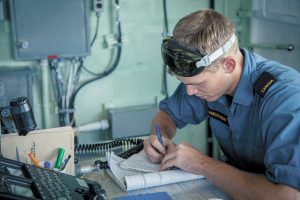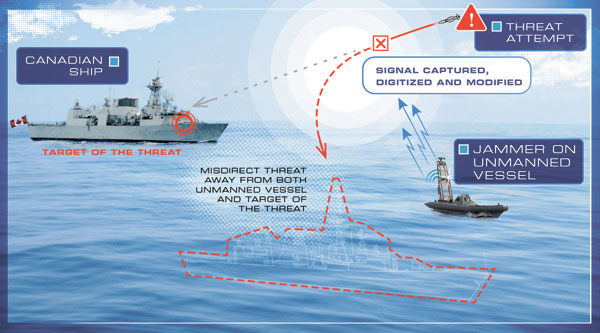Research centre works to enforce navy’s warship protection
By Lookout on Aug 20, 2016 with Comments 0

Ordinary Seaman Mark Narozanski from HMCS Vancouver prepares for the Multiple Ammunition Softkill System (MASS) firings for TAPA trials in the Pacific Ocean during RIMPAC 16. Photo by LS Sergej Krivenko, HMCS Vancouver
Samantha Bayard, Defence Research and Development Canada ~
It is getting increasingly complex to defeat a naval threat in today’s defence environment. However, Defence Research and Development Canada’s (DRDC) Radar Electronic Warfare team aims to provide the Royal Canadian Navy (RCN) with the technology it needs to defend against threats to its fleet.
“The objective of the project is the improved defence of naval ships against modern anti-ship missiles,” explains Frederic Arpin, lead defence scientist for the project at DRDC. “Improvements to current and future threats mean the RCN has less time to defend itself. It has become increasingly difficult with opponents having improved electronic protection measures to move threat targeting off the ship.”
A project is moving forward within the RCN to attain two to four systems for an operational evaluation.
“The project is going to allow us to purchase some commercial jammers because what we developed is experimental. It’s not rugged or combat ready in any sense,” says Arpin.
DRDC prepared the specifications for the project based on years of lessons. The jammer technology has evolved over 10 years of trials and data analysis. The first proof of concept was demonstrated with a basic noise jammer that tested its effect on threat simulators.
“The noise jammer was basically passive; we knew the frequency of the threat simulator and we just output noise,” explains Arpin.
The next step was to develop a coherent digital radio frequency memory (DRFM) jammer to target cutting-edge threats.
“The DRFM jammer captures and digitizes the incoming radio frequency pulse which the threat is transmitting. Next it stores and retransmits a modified signal that indicates a false target with different coordinates and a different signature,” says Arpin. “This technology is a smarter way of defeating the threat.”
The DRFM jammer is fitted on an unmanned vessel or drone, off-board of a nearby ship that would be the target of the threat. The jammer works on incoming frequencies and can either make the threat attack the unmanned vessel, thus protecting the main target, or modify the signal to misdirect the threat away from both the unmanned vessel and the target ship. Either outcome protects the lives of sailors on board nearby ships.
“After a jammer was suggested, Fred [Arpin] came up with the idea of putting the jammer on an autonomous vessel. That way no people were needed on the vessel to operate it,” explained Lieutenant-Commander Timothy Bromige, former Staff Officer Electronic Warfare at Canadian Forces Maritime Warfare Centre.
The project is part of the TAPA, or the Technical Cooperation Program Anti-ship Threat Project Arrangement. TAPA is an international organization that collaborates in defence scientific and technical information exchange and shared research activities for five nations: Australia, Canada, New Zealand, the United Kingdom and the United States.
“TAPA is very much cutting edge, looking five to 10 years into the future. That’s where you want to be,” explains LCdr Bromige.
TAPA conducts trials every two years as part of the Rim of the Pacific (RIMPAC) exercise and is one of its highest priority experiments since 2006. RIMPAC is the world’s largest international maritime exercise, comprised of nations with an interest in the Pacific Rim region. It is conducted from the Hawaiian Islands and southern California, and provides an important training opportunity and a means to strengthen military-to-military partnerships.
“RIMPAC is good because the ships are already there. We leverage all the international partners and assets. One of the tests we did in 2014 needed five ships; one Canadian ship, one Australian ship and three ships from the United States. We need a mix of different international assets to be able to run certain tests,” says Arpin, who is also the national lead for TAPA at DRDC.
“RIMPAC gives an immediate benefit to the participating navies,” explains LCdr Bromige. “There is cross pollination between the navies that take part, leveraging others work. It is not just what you do. Over the years working together and getting to know what each party wants and knows – the continuity – it’s like a marriage.”
The TAPA team put the experimental jammer to the test at this year’s edition of RIMPAC.

Filed Under: Top Stories
About the Author:





